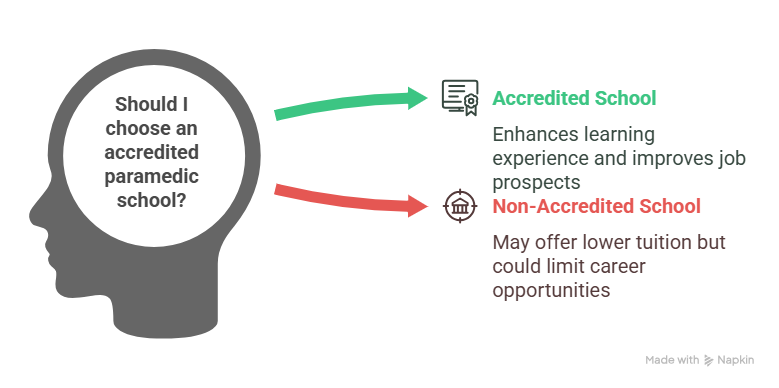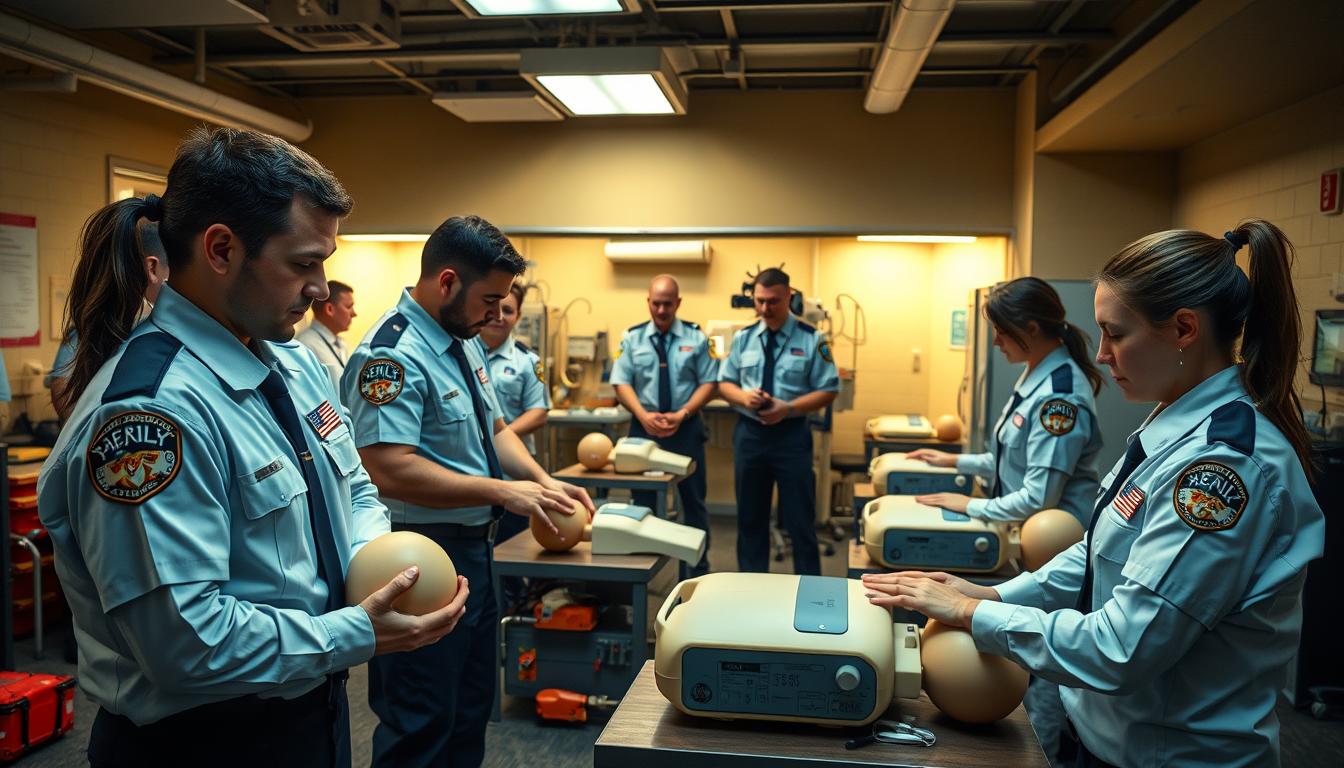Becoming a lifesaver is a noble career goal, and healthcare education plays a vital role in achieving it. In the United States, the demand for skilled paramedics is on the rise, driven by an aging population and an increased need for emergency medical services.
By enrolling in a reputable paramedic school, individuals can acquire the necessary skills to respond effectively in emergency situations. These programs teach students how to assess patients, administer medications, and provide critical care during transport to medical facilities.
With the right training, individuals can embark on a rewarding career in emergency medical services, making a real difference in their communities. By pursuing a career in this field, you’ll be part of a dedicated team that saves lives every day.
The Critical Role of Paramedics in Healthcare
As first responders, paramedics play a vital role in emergency medical services, requiring comprehensive emt training to handle a variety of life-threatening situations effectively.
First Responders on the Frontlines
Paramedics are often the first point of contact in medical emergencies, making their role crucial in the initial assessment and treatment of patients. Their ability to remain calm and make quick decisions under pressure is paramount. Effective medical responder training equips them with the skills necessary to provide immediate care.
Beyond Basic Emergency Care
Beyond basic first aid, paramedics are trained to administer advanced life support measures, including medication and cardiac rhythm interpretation. This advanced training is a hallmark of emt training programs, preparing paramedics for complex medical scenarios.
Impact on Patient Outcomes
The quality of care provided by paramedics significantly impacts patient outcomes, particularly in critical situations. Studies have shown that timely and appropriate pre-hospital care can reduce mortality rates and improve recovery chances. Thus, the importance of rigorous medical responder training cannot be overstated.
Paramedic School: Your Gateway to a Life-Saving Career
Embarking on a career as a paramedic requires a comprehensive education that equips you with the skills and knowledge necessary to save lives. Paramedic school is designed to challenge students and prepare them for the demands of working in emergency medical services.
Program Structure and Duration
Paramedic programs typically range from 1,200 to 1,800 hours, spread over 12 to 18 months. The program structure is carefully designed to cover a wide range of topics, from patient assessment and trauma care to emergency pharmacology.
Balancing Theory and Practical Skills
A key aspect of paramedic education is the balance between theoretical knowledge and practical skills. Students learn about advanced life support protocols and emergency medical procedures through a combination of classroom instruction and hands-on training.
The Intensity of Paramedic Education
Paramedic school is known for its intensity, pushing students to develop the skills and decision-making abilities required in high-pressure emergency situations. The rigorous training ensures that graduates are prepared to handle the challenges of working in emergency medical services.
By understanding the structure, balance, and intensity of paramedic school, prospective students can better prepare themselves for the journey ahead.
Prerequisites and Qualifications for Admission
The journey to becoming a paramedic begins with understanding the prerequisites for paramedic school admission. Aspiring paramedics must meet specific educational, certification, and physical requirements to be considered for enrollment.
Educational Background Requirements
Typically, paramedic programs require a high school diploma or equivalent as a minimum educational background. Some institutions may also require or prefer candidates with post-secondary education in a related field, such as emergency medical services (EMS) or healthcare.
EMT Certification as a Foundation
Most paramedic programs require candidates to be certified as an Emergency Medical Technician (EMT) before admission or during the early stages of the program. This foundational certification is crucial as it ensures that students have a basic understanding of emergency medical procedures.
Physical and Psychological Readiness
Paramedic training is physically and emotionally demanding. Candidates must be in good physical health and possess the psychological stamina to handle high-stress situations. Some programs may require a physical exam or psychological evaluation as part of the admission process.
Application Process and Competitive Selection
The application process for paramedic school can be competitive. It often involves submitting transcripts, certification documents, and letters of recommendation, followed by an interview. Creating a strong application package is crucial for standing out in a competitive pool.
| Requirement | Description | Importance Level |
|---|---|---|
| High School Diploma or Equivalent | Minimum educational requirement for most paramedic programs. | High |
| EMT Certification | Basic certification required for understanding emergency medical procedures. | High |
| Physical and Psychological Readiness | Essential for handling the demands of paramedic training. | High |
| Strong Application Package | Includes transcripts, certifications, and letters of recommendation. | Medium |
Types of Paramedic Training Programs
The path to becoming a paramedic involves selecting the right training program, with options including certificate, degree, and specialized pathways. Paramedic training programs are designed to equip students with the necessary skills and knowledge to excel in emergency medical services (EMS).
Certificate vs. Degree Programs
Paramedic training is offered through both certificate and degree programs. Certificate programs are typically shorter and focus on the specific skills required for paramedicine. In contrast, degree programs, such as Associate’s or Bachelor’s degrees in paramedicine or a related field, provide a more comprehensive education that includes both technical skills and academic coursework.
Community College Options
Many community colleges offer paramedic training programs that are affordable and well-regarded. These programs often have strong connections with local EMS providers, offering students valuable clinical experience and job placement opportunities.
University-Based Programs
University-based paramedic programs offer advanced degrees that can lead to higher-level positions in EMS or related fields. These programs often include research opportunities and advanced clinical training.
Military and Fire Department Pathways
Some paramedic training programs are specifically designed for military personnel or fire department employees. These programs may offer specialized training that aligns with the unique demands of these roles.
| Program Type | Duration | Focus |
|---|---|---|
| Certificate | 6-12 months | Technical skills for paramedicine |
| Associate’s Degree | 2 years | Technical skills and academic coursework |
| Bachelor’s Degree | 4 years | Advanced clinical training and research opportunities |
Core Curriculum and Skills Development
The core curriculum of paramedic schools focuses on developing critical skills for emergency medical responders. Through a combination of classroom instruction and hands-on training, students gain the knowledge and expertise needed to excel in emergency medical services.
Advanced Life Support Protocols
Paramedic training includes advanced life support (ALS) protocols, which enable responders to manage complex cardiac arrests, administer medications, and perform other life-saving interventions. ALS training is a critical component of emergency medical technician programs, preparing students for high-pressure situations.
Emergency Pharmacology and Medication Administration
Understanding pharmacology and being able to administer medications safely is crucial for paramedics. The curriculum covers a wide range of medications, their effects, and potential interactions, ensuring that students can make informed decisions during emergencies.
Trauma Care and Medical Emergencies
Paramedics must be equipped to handle both traumatic injuries and medical emergencies. Training includes assessing and managing trauma patients, as well as recognizing and responding to various medical conditions such as heart attacks, strokes, and allergic reactions.
Patient Assessment and Clinical Decision-Making
A key aspect of medical responder training is developing the ability to assess patients quickly and accurately, and to make informed clinical decisions based on that assessment. This involves understanding patient history, performing physical examinations, and using diagnostic tools effectively.
By focusing on these critical areas, paramedic programs ensure that graduates are well-prepared to provide high-quality care in a variety of emergency situations.
Clinical Rotations and Field Internships
Clinical rotations and field internships are crucial components of paramedic training programs, providing students with hands-on experience in real-world settings. These practical experiences are designed to complement the theoretical knowledge gained in the classroom, ensuring that paramedic students are well-prepared for the demands of the job.
Hospital Department Experiences
During their clinical rotations, paramedic students work in various hospital departments, such as emergency departments, operating rooms, and intensive care units. This exposure helps them understand the continuum of care and how their role fits into the broader healthcare system. By working alongside healthcare professionals, students gain insights into patient assessment, treatment options, and the importance of teamwork in high-pressure environments.
Ambulance Ride-Alongs
Ambulance service training is a critical aspect of paramedic education, and ambulance ride-alongs provide students with the opportunity to observe and participate in emergency medical services (EMS) operations. By accompanying experienced paramedics on calls, students learn how to apply their skills in real-time, manage emergency situations, and navigate the challenges of pre-hospital care.

Supervised Patient Care Opportunities
Under the supervision of experienced paramedics and healthcare professionals, students are given the chance to provide patient care, making decisions and taking actions that impact patient outcomes. This supervised experience is invaluable for building confidence and competence in a controlled environment.
Building Confidence Through Real-World Experience
The combination of clinical rotations and field internships offers paramedic students a comprehensive learning experience, preparing them for paramedic certification opportunities upon graduation. By the end of their training, students have gained the practical experience and confidence needed to excel in their roles and make a positive impact in their communities.
Choosing the Right Paramedic School for Your Goals
The journey to becoming a paramedic begins with choosing a school that aligns with your career goals and provides quality education. With so many options available, it’s crucial to consider several key factors when making your decision.
Accreditation and Program Reputation

Ensure the paramedic school is accredited by a recognized accrediting agency, such as the Commission on Accreditation of Allied Health Education Programs (CAAHEP). A reputable program not only enhances your learning experience but also improves your job prospects.
Pass Rates and Student Outcomes
Research the school’s pass rates for the National Registry of Emergency Medical Technicians (NREMT) exam. High pass rates indicate effective teaching and preparation.
Cost Considerations and Financial Aid
Evaluate the total cost of the program, including tuition, fees, and equipment. Explore available financial aid options, such as scholarships, grants, and loans, to help manage these costs.
Program Flexibility for Working Students
If you need to balance your studies with work or other responsibilities, look for programs that offer flexible scheduling, online coursework, or part-time enrollment options.
| Factor | Importance | What to Look For |
|---|---|---|
| Accreditation | High | CAAHEP or equivalent accreditation |
| Pass Rates | High | Above national average NREMT pass rates |
| Cost | Medium | Competitive tuition, available financial aid |
| Flexibility | Medium | Flexible scheduling, online or part-time options |
By carefully considering these factors, you can make an informed decision and choose a paramedic school that supports your career aspirations.
Certification and Licensing After Graduation
Certification and licensing are the keys to unlocking a successful paramedic career after graduation. To practice as a paramedic, one must not only complete the required education but also obtain the necessary certifications and licenses to work in their state.
National Registry of Emergency Medical Technicians (NREMT) Exam
The first step towards certification is passing the National Registry of Emergency Medical Technicians (NREMT) exam. This exam is a standardized test that assesses a candidate’s knowledge and skills in providing emergency medical care. It includes both written and practical components, ensuring that paramedics are proficient in handling various emergency situations.
State-Specific Requirements
While the NREMT exam is a national standard, certification requirements can vary by state. Some states require additional certifications or licenses beyond the NREMT certification. It’s essential for paramedics to check their state’s specific requirements to ensure they are eligible to practice.
Continuing Education Requirements
To maintain certification, paramedics must complete continuing education requirements. These requirements ensure that paramedics stay updated with the latest medical practices and technologies.
Specialty Certifications for Career Advancement
Beyond basic certification, paramedics can pursue specialty certifications to advance their careers. These certifications demonstrate expertise in specific areas.
| Certification Type | Description | Eligibility |
|---|---|---|
| NREMT Certification | National standard for paramedic certification | Completion of paramedic program |
| State-Specific Certification | Additional certification required by some states | Varies by state |
| Specialty Certifications | Demonstrates expertise in specific areas | Varies by certification |
Career Paths and Opportunities for Paramedics
The career landscape for paramedics is diverse, offering numerous options for those who have completed first responder classes. With their advanced EMT training, paramedics can pursue various career paths that are both challenging and rewarding.
Traditional EMS and Ambulance Services
Many paramedics start their careers in traditional EMS and ambulance services, responding to emergency calls and providing critical care during transport to medical facilities.
Fire Department Integration
Paramedics can also integrate into fire departments, working alongside firefighters to provide medical emergency responses.
Critical Care Transport Teams
Critical care transport teams require paramedics with specialized training to care for critically ill patients during transport between medical facilities.
Emergency Department and Hospital Roles
Paramedics can work in emergency departments and hospitals, assisting with patient care and supporting other healthcare professionals.
For those interested in aviation medicine, becoming a flight paramedic offers a unique and exciting career path, providing medical care during air transport.
Tactical and Special Operations
Some paramedics are drawn to tactical and special operations, working with law enforcement and other specialized teams to provide medical support in high-risk situations.
Conclusion: Embarking on Your Paramedic Journey
Embarking on a career as a paramedic is a significant decision that requires dedication, hard work, and a passion for saving lives. Through , individuals can gain the necessary skills and knowledge to excel in this demanding yet rewarding field.
As discussed, programs provide a comprehensive education in healthcare, covering critical areas such as advanced life support protocols, emergency pharmacology, and trauma care. By balancing theoretical foundations with practical skills training, these programs prepare students for the challenges of real-world emergency medical services.
Pursuing a career in paramedicine not only offers personal fulfillment but also contributes to the greater good of . By choosing the right paramedic school and program, individuals can set themselves up for success and make a meaningful difference in their communities.
With the knowledge and skills gained through paramedic training, individuals can confidently respond to emergency situations, providing critical care when it’s needed most. Take the first step towards a rewarding career in paramedicine by exploring options today.
FAQ
What are the prerequisites for enrolling in a paramedic school?
Typically, paramedic schools require applicants to have a high school diploma or equivalent, be at least 18 years old, possess a valid EMT-Basic certification, and have a certain number of hours of emergency medical experience.
How long does it take to complete a paramedic training program?
The duration of paramedic training programs varies, but most programs take around 1-2 years to complete, depending on whether you’re pursuing a certificate or an associate’s degree.
What is the difference between a paramedic certification and a license?
Paramedic certification is typically obtained through the National Registry of Emergency Medical Technicians (NREMT) exam, while licensing requirements vary by state. Some states require paramedics to be licensed in addition to being certified.
Can I attend paramedic school online?
While some aspects of paramedic training can be completed online, such as coursework, clinical rotations and field internships require in-person attendance. Many schools offer hybrid programs that combine online learning with hands-on training.
What kind of job opportunities are available to paramedics?
Paramedics can work in a variety of settings, including traditional EMS and ambulance services, fire departments, critical care transport teams, emergency departments, and hospitals. Specialized opportunities like flight paramedicine and tactical operations are also available.
How do I choose the right paramedic school for my needs?
When selecting a paramedic school, consider factors such as accreditation, program reputation, pass rates, cost, and flexibility for working students. Researching these factors can help you make an informed decision.
What are the continuing education requirements for paramedics?
Paramedics are required to complete continuing education hours to maintain their certification and licensure. The specific requirements vary by state and certification level.
Can I specialize in a particular area of paramedicine?
Yes, paramedics can pursue specialty certifications in areas like critical care transport, flight paramedicine, or tactical operations. These specializations can enhance career advancement opportunities.




